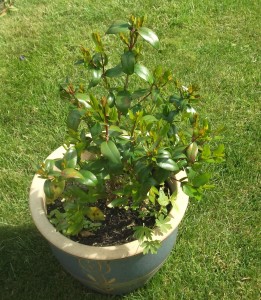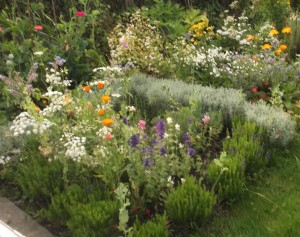 This is myrtus communis, the sweet myrtle. When it matures it should have deliriously pretty white flowers, but this plant may take a year or two more before it gets to that point. It isn’t reliably hardy in Scotland, so it lives in the greenhouse in the winter, and will have to stay in a pot whether it likes it or not.
This is myrtus communis, the sweet myrtle. When it matures it should have deliriously pretty white flowers, but this plant may take a year or two more before it gets to that point. It isn’t reliably hardy in Scotland, so it lives in the greenhouse in the winter, and will have to stay in a pot whether it likes it or not.
Myrtle is the emblem of fertility and faithful love, so was often used to makes wreaths and bouquets for brides. Its leaves are fragrant, with a fresh pungent scent similar to eucalyptus (to which it is related) but with a deeper note something between rosemary and bay. They have been used in pot pourris, and I have discovered a recipe for furniture polish in Lesley Bremness’ World of Herbs, which includes a strong infusion of myrtle leaves.
Of recent years I have noticed reference to their culinary use in Mediterranean and Middle Eastern recipes, and I’ve even seen dried leaves on sale in larger branches of Tesco, but the scent is so powerful I haven’t yet had the nerve to try it.
Myrtle is the fiftieth herb on my list, and marks the end of this phase of the Half a Hundred Herbs project. I’ve learned a lot, grown a lot of new herbs, met some very interesting people and seen some fabulous gardens. The next phase won’t be quite so intensive. There are poems cooking, and some thoughts about the way we use herbs, some practical, some magical and some ideological, that I will be exploring. I’m going to focus a bit more on the way I use herbs, on the cooking and gardening and preserving, on remedies and the use of scent and colour, and the ecology and biodiversity implications of growing and foraging. I hope you have enjoyed the posts so far and that you will stick with me as we go into phase 2. In the meantime, I’ll leave you with a picture of the world’s smallest knot garden at its height in August.

Leave a Reply